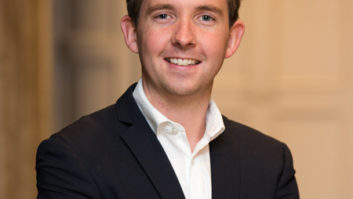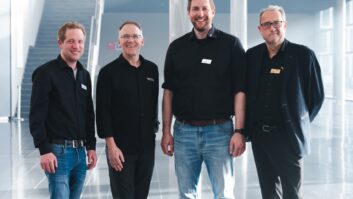Questioned had been raised about the need for another trade show in the region however, Scattered Media, the organisers of the show, believed a bespoke networking forum to serve the ever-changing needs of the industry would be welcome.
Darren Brechin, director, Scattered Media, commented: “We had said all along that we firmly believed in the small, intimate two-day format supported by a strong, well-researched education programme. After the success of our inaugural UK event in February we were confident that the model we had put in place would be successful. We worked extremely hard to deliver an audience that normally our exhibitors would not have access to at other trade exhibitions, and we believe we successfully achieved our objectives.”
The aim of the organisers was to allow easy access for both local and international visitors alike, the venue was a key element of the marketing promotion clearly highlighting the ease with which overseas visitors could simply come for a ‘day trip’, and judging by the attendance this appears to have been a clever tactic.
Hanslee Azhar, regional director, Scattered Media Asia, said: “We set out to create something different, an event that would inspire visitors who would not normally attend trade exhibitions to leave their offices for a day to come and educate themselves on the new technologies in the market place. Our objective for year one was to achieve 30 individual exhibition stands and deliver 1,000 key buyers from Singapore and its neighbouring countries. We finished with 34 booths and 1,067 unique visitors from countries such as Malaysia, Indonesia, Vietnam, the Philippines, India and Thailand as well as Singapore, thus I can happily say we achieved what we set out to do.
“We focused our attention on marketing to a select few, as opposed to marketing to the masses – we set clear messages and spent a lot of time and effort building databases from the various countries around the region so that these messages would be reaching the correct people. We wanted consultants, developers, technicians and engineers – top quality end users to attend. Our experience has told us that to deliver this type of audience, we would have to make sure we had direct access to these individuals hence our emphasis on building quality databases.”
This proved to be a successful manoeuvre as exhibitors were overjoyed at the quality of the attendees that visited their booths. Loud Technologies Asia-Pacific sales director Dawvinder Sheena commented: “We have received five orders for the UMX96 console here at the show, which is staggering. Naturally, we invited many of our customers in the region to attend, but we have also met many new faces.” Similarly pleased was T J Lim, business development manager of Audio-Technica SEA, who said: “We have met some interesting new business contacts from churches and event organisers. Being a new trade show, we didn’t really know what to expect, but have been pleasantly surprised.”
DiGiCo marketing director Dave Webster had taken the decision to support his regional distributor following the InfoComm show held in Las Vegas the week before. “This trade show seemed very quiet and small after InfoComm, but it works as all the visitors took an interest in the SD7 and want to get their hands on it. There are no time wasters here and we have seen quite a few people from Indonesia, Malaysia and beyond.”
Lab.gruppen’s Thomas Mittelmann agreed with this sentiment. “This is a really cool, relaxed show as the decibels are not drowning out the conversation, as so often happens at the big shows,” he said.
d&b audiotechnik south-east Asia managing director, Sebastian Song was of a similar frame of mind. He commented: “We cannot exhibit at every trade show and like to try new concepts. It was a risk exhibiting here, but luckily it has paid off and we’ll be returning next year.”
evenTech Singapore 2009 will take place from 1-2 July 2009 at the Singapore Expo. The organisers believe that the success this year’s exhibitors experienced will allow them to develop and mould the show to become better and even more focused for next year.
“The first stage of our development has been achieved – that was to create a platform that people believed in and found a worthwhile investment. The next stage is to keep on moulding and tweaking the show in accordance with the needs and wants of both our exhibitors and visitors so that we have a genuine tailored platform that acts as an essential marketing tool for the commercial audio and professional AV industry in south-east Asia. We will continue to source data to attract more regional visitors, and we will again work very closely with the industry to deliver an even stronger education programme for 2009,” concluded Azhar.
For more information:
www.eventech-singapore.com
The new company has 250 employees and its coverage across the UK has doubled in size, with offices in London and the south-east, Bristol, Leeds, Birmingham and Scotland. Combined turnover will total £45 million. AVM has over 700 clients around the world, including BP, BT, eBay, Sainsbury’s and Virgin.
With current turnover of £23 million, Matrix is a leading provider of audiovisual services to the UK education sector. It also has a significant client base in corporate and public organisations, and is a main supplier of AVSI services to the Ministry of Defence.
Backed by Octopus Private Equity and HSBC, AVM has pursued an aggressive growth strategy, with Matrix being the company’s sixth acquisition in the past three years.
Edward Cook, CEO of AVM, said: “We are delighted to bring Matrix and its staff into the AVM Group. Matrix provides us with a wealth of experience and a sizeable customer base. By combining this with AVM’s already impressive client portfolio, we have created the UK’s largest provider of AV and video conferencing services. This enables us not only to improve and broaden the services we offer our customers, but to take a leadership position in one of the UK’s most exciting and dynamic industries.
“In companies around the world, the boardroom is being transformed into a multimedia communications hub that reflects the way in which business is conducted. In fewer than 10 years, we have gone from flipcharts and overhead projectors to large-scale, fully interactive plasma screens with professional acoustic design. The advent of high-speed broadband connectivity has also made video conferencing a realistic option, whereas before it was cost-prohibitive and cumbersome. As a key green technology, we expect to see rapid growth in this market in the next few years.”
Sandy MacPherson, chairman of AVM, said: “This latest deal firmly establishes us as the dominant player in the UK’s fast-growing AVSI market. As both private and public sector organisations demand more sophisticated AV and video conferencing solutions, we are seeing increasing consolidation within the UK industry – this development is fully in line with our strategy to continue to expand via acquisition. With our extensive international partnership programme, we are also in a great position to grow our global customer base.”
For more information:
www.avmachines.com
Heathrow Airport Centre is where British Airways looks after the smooth running of its flights from all the airport’s terminals, including Terminal 5 where it is located. The centre’s role is to look after all the processes that go into ensuring that planes are ready to leave their gates on time. This encompasses allocating staff to functions such as check-in; boarding; loading and baggage; stand planning – allocating gates to aircraft as they come in to land; liaising with the crew of aircraft on the stand about their likely departure times, and with other staff about other logistical matters such as restocking meals.
The centre also needs to be aware of factors outside the airport that could have a bearing on its resources, especially its people. For instance, at the time of IE’s visit, the M4 motorway has been closed in both directions because of a road accident. The centre manager needs to be aware of this, ensuring that there is cover in place for any staff who may have been delayed on their journey, and alerting staff still at home that they may need to leave earlier to get in on time.
As you’d expect, with so much information being captured and acted upon, there is a plethora of equipment dedicated to displaying information visually. Each of the 64 desks has at least three PC monitors – two in portrait mode and one in landscape. But the centrepiece of the room is a Mitsubishi video wall consisting of 16 50in DLP cubes in a 2×8 formation.
Flexible options
There is a great deal of flexibility in what can be displayed on the wall, in terms of both sources and the way in which they are shown. In its standard configuration, the wall displays a live airfield map, showing the positions of all the planes on the ground (labelled with flight numbers); a rolling update on the status of all flights; statistics for ‘focus flights’, the flights which the airline’s management are most concerned about; and a list of incoming flights that are being kept in holding patterns above the airport. Incoming flights need to be watched because of the possibility of knock-on delays for departures.
In addition, the system can display TV channels – useful in the event of a major breaking news story – and DVD content. There is also an auxiliary input for connecting laptop computers to show presentations. Audio from all of these sources is relayed via a Kramer audio switcher, through Cloud amplifiers to a set of about 30 Tannoy ceiling speakers.
What is displayed on the video wall is primarily decided by two terminal controllers, who sit at the front of the room, closest to the video wall (and, ironically, with their backs to it). Sources, and the sizes at which they are displayed, are selected by means of a Crestron touchpanel.
The centre became operational in January 2008, a couple of months before the ill-fated opening of Terminal 5 to air traffic in March. It occupies a central position within the new terminal building, but does not enjoy the views of its previous location, as BA design lead Mark Fielder explains: “In the Compass Centre, we were in the top of the building and we had a panoramic view out of the windows over the whole airport. Here we’ve got a panoramic view of not much at all.”
David Jones, business manager for professional cube products at Mitsubishi Display Engineering, adds: “The original concept was that we were going to put in a video wall and create a window onto the airport – because they were going from seeing all the planes they were dealing with coming in and going out, to seeing nothing.”
Using the wall to display operational information was originally going to be “a sideline”, says Jones. However, issues arose over who would own and maintain the cameras that would capture the necessary information, and so the brief became for a pure information display.
Fielder is happy with this arrangement. “We don’t actually need to look at the aircraft, but it gave the [old] room an operational focus,” he says. “The video wall does the same thing – but what we’ve got here is all the key operational information.”
Steve Giardina, commercial manager of integrator Asysco, explains that various display technologies were investigated, but rear-projection cubes were decided upon as the best solution. “The client wanted to create a one-screen solution, with everything on a single large display – and this was the only way of doing it,” he explains.
Available space
The dimensions of the video wall were to a great extent set by the available space – the ceiling height, the width of the wall on which it is mounted – and even the depth. Because the arrangement of desks put pressure on the depth of the room, a model of cube was chosen that is slightly shallower than average – 595mm, while some models can be up to 700mm deep.
Each image on the screen is controlled by a different PC; outputs from these pass to a central processor which combines these inputs and splits the full image into its 16 component parts, passing a video signal to each cube.
Other kit in the installation includes Extron distribution amplifiers, which take video feeds and splits them between the processor and a preview screen, and a keyboard and mouse switch for direct control of the PCs in the racks.
Terminal controller Jane Braithwaite is enthusiastic about the usefulness of the video wall. “We had nothing like this before – it’s fantastic,” she says. Some of the tools, such as the airfield map, were only accessible to some of the staff, she adds. She also praises its usefulness as a communications tool. “Everyone can see what we’re talking about – if you want to put something up there on a presentation, people have got no excuse for not knowing about it. So it’s very good.”
Centre manager Becci Grogan reports that the ‘focus flights’ screen on the wall is an extremely effective management tool. These flights are presented in a list, she explains, and “along the top are the different areas – crew, turnaround management, passenger services, baggage and aircraft movement – and their engagement times. When a time turns red, it means that department hasn’t engaged on time. It sends a powerful message that that’s what we’re watching.”
Pat Dobie, work stream leader – T5 planning & control, is also positive: “The installation of the video wall was a first for BA. It has changed the entire outlook within the Heathrow Airport Centre. It has been well received by the staff, who now depend on it for the display of key operational information. As the Airport Centre covers a large floor plate area, the video wall has been the conduit to displaying reliable, consistent information in a timely manner, on which to base day to day decisions.”
www.cloud.co.uk
www.crestron.com
www.exterity.co.uk
www.extron.com
www.jupiter.c







